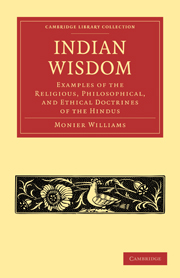Book contents
- Frontmatter
- PREFACE
- THE INDO-ROMANIC ALPHABET WITH THE EQUIVALENT SANSKṚIT LETTERS AND RULES FOR PRONUNCIATION
- Contents
- INTRODUCTION
- LECTURE I The Hymns of the Veda
- LECTURE II The Brāhmana Portion of the Veda
- LECTURE III The Systems of Philosophy
- LECTURE IV The Nyāya System of Philosophy
- LECTURE V The Sānkhya System of Philosophy
- LECTURE VI The Mimāṉsā System of Philosophy
- LECTURE VII Irregular Systems and Eclectic School
- LECTURE VIII Smṛiti. The Vedāngas
- LECTURE IX Smārta-sūtra. Gṛihya, ‘domestic rules’
- LECTURE X The Law-books. Mainu continued
- LECTURE XI Metrical Version of some of Manu's Moral and Religious Precepts
- LECTURE XII The Epic Poems
- LECTURE XIII The Mahā-bhārata
- LECTURE XIV The Epic Poems compared together and with Homer
- LECTURE XV The Artificial Poems
- INDEX
- ADDITIONS AND CORRECTIONS
- ORIENTAL WORKS
LECTURE X - The Law-books. Mainu continued
Published online by Cambridge University Press: 29 August 2010
- Frontmatter
- PREFACE
- THE INDO-ROMANIC ALPHABET WITH THE EQUIVALENT SANSKṚIT LETTERS AND RULES FOR PRONUNCIATION
- Contents
- INTRODUCTION
- LECTURE I The Hymns of the Veda
- LECTURE II The Brāhmana Portion of the Veda
- LECTURE III The Systems of Philosophy
- LECTURE IV The Nyāya System of Philosophy
- LECTURE V The Sānkhya System of Philosophy
- LECTURE VI The Mimāṉsā System of Philosophy
- LECTURE VII Irregular Systems and Eclectic School
- LECTURE VIII Smṛiti. The Vedāngas
- LECTURE IX Smārta-sūtra. Gṛihya, ‘domestic rules’
- LECTURE X The Law-books. Mainu continued
- LECTURE XI Metrical Version of some of Manu's Moral and Religious Precepts
- LECTURE XII The Epic Poems
- LECTURE XIII The Mahā-bhārata
- LECTURE XIV The Epic Poems compared together and with Homer
- LECTURE XV The Artificial Poems
- INDEX
- ADDITIONS AND CORRECTIONS
- ORIENTAL WORKS
Summary
THE Code of the Mānavas, which we have assigned in its present form to about the fifth century b.c. (see p. 215), and which for convenience we may call ‘Manu's Law-book,’ is a metrical version of the traditions (smṛiti) of the Mānavas, probably before embodied in their Gṛihya and Sāmayāćārika Sūtras (p. 214), the metre being Anushtubh or that of the common Ṥloka (p. 166). My aim in the present Lecture will be to analyze and arrange in a connected manner the contents of the Code, offering prose translations of selected passages and pointing out in a general way the characteristic features of (1) its sacred knowledge and religion, (2) its philosophy, (3) its Āćāra or ‘social rules and caste organization,’ (4) its Vyavahāra or ‘criminal and civil laws and rules of government,’ (5) its system of Prāyaś-ćitta or ‘penance,’ (6) its system of Karma-phala or ‘future recompenses of acts done in this life.’ In the next Lecture I propose to give specimens of the most striking passages, under the last four heads, in a metrical English version.
I. First, then, as to its religious teaching. We may notice that this generally agrees with the later Vedic period, especially that represented by the Purusha-sūkta and some of the Brāhmaṇas.
- Type
- Chapter
- Information
- Indian WisdomExamples of the Religious, Philosophical, and Ethical Doctrines of the Hindus, pp. 221 - 281Publisher: Cambridge University PressPrint publication year: 2010First published in: 1875

